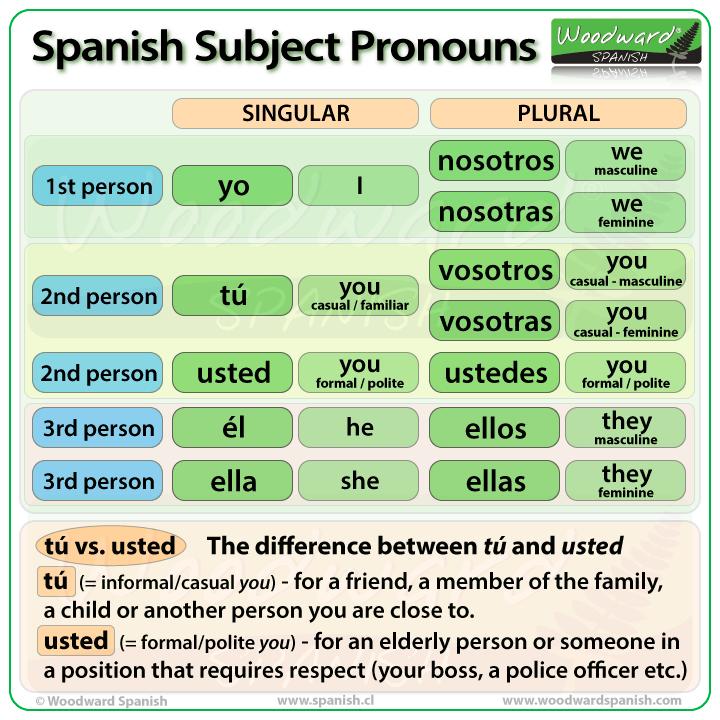Overview
Telling a story can get tiring pretty quickly if you have to keep saying every person´s name over and over. This is where personal pronouns (subject pronouns) come in pretty handy. Personal pronouns replace a subject noun or name and they are classified several different ways: number (singular, plural), person (1st, 2nd, 3rd person), gender (male, female), and formality (formal or informal). Luckily, there is a handy chart that holds all this information. For more detail on when and how to use each pronoun, see the notes below.
¡Cuidado! If in doubt, don’t use it! While personal pronouns can be used to replace a person’s name, advanced and native speakers of Spanish rarely use them since the verb ending tells you who the subject is.
The words “I” “you” “he” “she” “we” “you-all” and “they” are called subject pronouns. Spanish has corresponding subject pronouns. Here’s a list of the English subject pronouns and their Spanish equivalents:
- yo
- I
- usted
- you
- él
- he
- ella
- she
- nosotros
- we
- ustedes
- you-all
- ellos
- they
Spanish subject pronouns are both similar to and different from their English counterparts. Let’s examine some of the differences. Look more closely at the English word “you.”
You have just seen that this can be translated into Spanish as “usted.” But there is also a second way it can be translated. There are two ways the English word “you” can be expressed in Spanish:
Spanish has a formal and an informal form of the word “you.” “Usted” is more formal and is generally used to express respect. “Tú” is more familiar and is used among friends, coworkers, relatives, or when addressing a child.
Speaking to your boss: usted
Speaking to your daughter: tú
Speaking to your teacher: usted
Speaking to your friend: tú
usted = you formal
tú = you informal (familiar)
This same distinction with regard to degree of formality occurs in the plural form as well. When referring to “you-all,” there are two choices in Spanish:
ustedes
you-all formal
vosotros
you-all familiar
Once again, the difference lies in the degree of formality conveyed by the speaker. However, the vosotros form is used primarily in Spain. Throughout Latin America, “ustedes” is generally used in both formal and informal situations to refer to “you-all.”
Speaking to a group of children
(in Spain): vosotros
Speaking to a group of children
(in Latin America): ustedes
Speaking to a group of strangers
(in Spain): ustedes
Speaking to a group of strangers
(in Latin America): ustedes
Note: usted can be abbreviated Ud. or Vd. ; ustedes can be abbreviated Uds. or Vds.
In many ways, Spanish is more gender-specific than English. We find evidence of this in the subject pronouns. First, look at the word “nosotros.” This means “we” in the sense of a group containing at least one male. If the group contains only females, the word “nosotras” is used. So, in Spanish, there are two ways to say “we”:
nosotros
we (masculine or mixed group)
nosotras
we (feminine)
This same idea applies to the English word “they”:
ellos
they (masculine or mixed group)
ellas
they (feminine)
This same idea also applies to the “vosotros” form:
vosotros
you-all familiar (masculine or mixed group)
vosotras
you-all familiar (feminine)
Note: These forms are used primarily in Spain, not Latin America.
Finally, don’t get confused over the difference between talking to a group or talking about a group. Consider the following statement, which could have been made by your Spanish teacher, while standing before the class:
“You-all need to study your Spanish. Those students in the other class don’t need to study Spanish. They are studying French. You-all can practice Spanish in Spain. They can practice French in France.”
The teacher is talking to the Spanish students and about the French students.
Talking to a group, use “you-all”:
ustedes
vosotros
vosotras
Talking about a group, use “they”:
ellos
ellas
Here’s the complete list of Spanish subject pronouns:
Singular
yo – I
tú – you (familiar)
él – he
ella – she
usted – you (formal)
Plural
- nosotros
- we (masculine or mixed gender)
- nosotras
- we (feminine)
- vosotros
- you-all (familiar, Spain, masculine or mixed gender)
- vosotras
- you-all (familiar, Spain, feminine)
- ellos
- they (masculine or mixed gender)
- ellas
- they (feminine)
- ustedes
- you-all (formal in Spain, formal and familiar in Latin America)
|
Singular |
Plural |
| 1st person |
yo (I) |
nosotros (we, masculine)
nosotras (we, feminine) |
| 2nd person |
tú (you, familiar)
vos (you, familiar)
usted (you, formal) |
vosotros (you, masculine)
vosotras (you, feminine)
ustedes (you, formal) |
| 3rd person |
él (he)
ella (she) |
ellos (they, masculine)
ellas (they, feminine) |
yo (I)
- As you can see, it is not necessary to capitalize “yo” in Spanish like you capitalize “I” in English. It is, of course, capitalized at the beginning of a sentence.
tú (you, singular informal)
- Spanish has two ways of speaking directly to someone: formally and informally. When you are talking directly to children, relatives, friends, peers, or pets, you should “tú,” the informal address.
- Tú carries a tilde to distinguish it from the possessive adjective “tu” meaning “your.”
vos (you, singular informal)
- Means the same thing as and is used instead of “tú”
- Is used mainly in what is known as the Southern Cone of Latin America (Argentina, Chile, Paraguay, and Uruguay), so don’t try to use it in Spain.
usted (you, singular formal)
- Usted is used to directly address someone older, a person you do not know, a superior, or someone you would like to show a lot of respect.
- You can abbreviate usted as “Ud.” It should always be capitalized and with a period in the abbreviated form.
- While categorized as a 2nd person pronoun, verbs in the Ud. form are conjugated as if they are 3rd person singular. More on this in the verbs lessons.
él, ella (he, she)
- Use these pronouns in place of a person’s name.
- Él carries a tilde to differentiate it from the definite article “el” meaning “the.”
- No special notes about “ella” except a reminder that is pronounced like a (eh-yah).
nosotros, nosotras (we)
- Use nosotros/as when speaking about a group of which you are a part.
- The only difference between nosotros and nosotras is in gender.
- Nosotros is masculine and is used to refer to a group of men only or a group mixed of men and women. (Even if there are 99 women and 1 man, still use the masculine form.)
- Nosotras is feminine and is only used when the entire group is female.
vosotros, vosotras (you, plural informal)
- Vosotros/as is used to speak directly to a group of people you are very familiar with (see tú)
- Vosotros is used as the informal, or familiar, form of “you” plural in Spain. Most other Spanish-speaking countries do not use vosotros.
- Vosotros/as follows the same rules as nosotros: all men and mixed groups: vosotros, all women: vosotras.
ustedes (you, plural formal)
- Since vosotros is only used in Spain, ustedes is used to speak directly to a group of people in both formal and informal situations.
- Ustedes is commonly abbreviated as “Uds.”
- While categorized as a 2nd person pronoun, verbs in the Uds. form are conjugated as if they are 3rd person plural. More on this in the verbs lessons.
ellos, ellas (they)
- Ellos and ellas follow the same rules as nosotros and vosotros for gender: all men and mixed groups: ellos, all women: ellas
- Use ellos/as when you are replacing more than one person’s name or are talking about a group of people
Subject Pronouns in Spanish
The subject pronouns in Spanish are:
|
Singular |
Plural |
| 1st Person |
yo |
nosotros, nosotras |
| 2nd Person |
tú, usted |
vosotros, vosotras, ustedes |
| 3rd Person |
él, ella |
ellos, ellas |
1st Person = the person who is speaking
2nd Person = the person you are speaking to or listening to
3rd Person = the person you are talking about
An explanation of what each Personal Pronoun is:
| Personal
Pronoun |
|
Situation |
| Yo |
I |
= it refers to yourself |
| Tú |
You |
= the person you are speaking to – informal (family or friend) |
| Vos |
You |
= you in Argentina |
| Usted |
You |
= the person you are speaking to – formal (respect, older people) |
| Él |
He |
= man or boy (another person) |
| Ella |
She |
= woman or girl (another person) |
| Nosotros * |
We |
= tú + yo OR Usted + yo |
| Nosotras * |
We (fem) |
= tú + yo OR Usted + yo (both are women / girls) |
| Vosotros |
You |
= tú + tú (this is not used much in Latin America) |
| Vosotras |
You (fem) |
= tú + tú (only women – this is not used much in Latin America) |
| Ellos ** |
They |
= él + él OR él + ella |
| Ellas ** |
They (fem) |
= ella + ella (only women or girls) |
| Ustedes |
You |
= Usted + Usted (= tú + tú in Latin America) |
* Nosotros vs Nosotras
There are two ways of saying “We” in Spanish depending on who is speaking or in the “group”.
If there is at least one man (or boy) in the “group” of people, then “We” will be
Nosotros in Spanish.
If there are only women (or girls) in the group, and no men, then “We” will be
Nosotras in Spanish.
You (man) + Man = Nosotros (= yo + él)
You (man) + Woman = Nosotros (= yo + ella)
You (woman) + Man = Nosotros (= yo + él)
You (woman) + Woman =
Nosotras (= yo + ella)
** Ellos vs Ellas
The same applies to “They” (ellos or ellos). If there is one or more men in the group, then it will be
ellos.
If everyone in the group is female, then you would use
ellas.
Subject Pronouns in Spanish – Summary Charts


Subject Pronouns
Every sentence has a subject. The subject of the sentence is who or what is doing the action in the sentence or is being described.
In English, the subject pronouns are I, you, he/she/it, we, they.
In Spanish there are several other forms of these subject pronouns. As with many other grammatical forms, there are different gender forms of pronouns.
| English Subject Singular Pronoun |
Spanish Subject Singular Pronoun |
English Subject Plural Pronoun |
Spanish Subject Plural Pronoun |
| I |
yo |
We |
nosotros (masculine or mixed gender group)
nosotras (feminine) |
| you |
tú (familiar form used with friends, co-workers, children)
ustede (formal form used with superiors, strangers, children to adults) |
you (as in all of you) |
ustedes (used in Latin American countries for both formal and informal, used in Spain for formal)
vosotros (informal masculine and mixed gender groups -used in Spain)
vosotras (informal feminine – used in Spain) |
| he
she |
él
ella |
they |
ellos (masculine or mixed gender group)
ellas (feminine group) |



